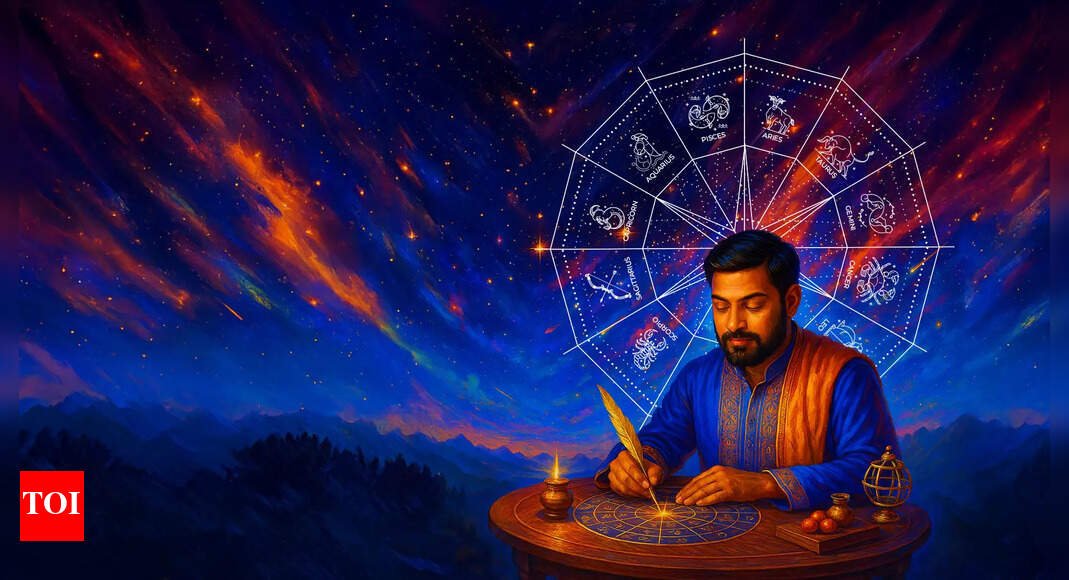AI Baba Vanga predictions for 2026: What the virtual psychic might foresee about the future |

Baba Vanga, born Vangeliya Pandeva Dimitrova in 1911, is remembered as one of the most enigmatic figures of the 20th century. Often called the “Nostradamus of the Balkans,” she reportedly made hundreds of predictions during her lifetime before passing away in 1996. Many of her alleged prophecies, from global disasters to political transformations, have become a source of endless fascination online, though most remain unverified and highly interpretive. Over the years, her name has resurfaced whenever the world faces uncertainty, with new claims of her foresight making headlines.Now, in an age defined by artificial intelligence, her legacy has taken on a new digital life. To explore what the mystic might foresee if she were alive today, we turned to AI for answers. Using a generative chatbot, we asked a single question:“If Baba Vanga was still alive today, what would she predict for 2026?”What emerged is a reconstructed portrait of what the “AI Baba Vanga” could envision for the near future, touching on global conflict, climate instability, breakthroughs in artificial intelligence, and medical revolutions. While entirely speculative, this AI-generated perspective mirrors the same themes that have long defined Baba Vanga’s mystique: humanity’s eternal quest to glimpse what lies ahead.
AI Baba Vanga’s key predictions for 2026
While the AI-generated reconstruction is purely speculative, it draws from global trends and recurring motifs found in Baba Vanga’s attributed prophecies. Here are the main themes that “AI Baba Vanga” might highlight for 2026:
1. Technological singularity and AI dominance
The AI simulation suggests that 2026 could mark a pivotal year in human–machine relations. According to the model, Baba Vanga would have foreseen “the rise of the unseen mind,” referring to artificial intelligence surpassing certain human cognitive tasks. In practical terms, this reflects real-world trends where AI systems are becoming more integrated into governance, healthcare, defence, and finance.The forecast implies a year when humanity begins to feel the full impact of rapid automation, raising questions about ethics, job displacement, and digital control.
2. Environmental upheaval and natural disasters
A recurring element in Baba Vanga’s prophecies is environmental turbulence. The AI interpretation connects this to escalating climate change indicators expected around the mid-2020s. It envisions “the earth’s breath turning to storm,” symbolic of increased frequency of cyclones, wildfires, and floods.Scientific reports support the possibility: data from the World Meteorological Organisation (WMO) indicate that global temperature records continue to be broken, and extreme weather events are intensifying across continents. In this sense, AI Baba Vanga’s “vision” reflects genuine environmental risk patterns already being documented.
3. Shifts in global power and economic instability
The AI-generated vision also references a phase of “silent wars and shifting borders,” which could symbolise trade realignments, political restructuring, or regional conflicts. The forecast aligns with ongoing geopolitical uncertainties from currency fluctuations to changing alliances in Asia, Europe, and the Middle East.According to economic projections by the IMF and World Bank, 2026 may witness continued stress on global supply chains, particularly in energy, food, and technology sectors. The AI version of Baba Vanga’s prophecy interprets this as “the fall of old towers and the birth of new markets,” suggesting a shift in economic dominance.
4. Medical and biological breakthroughs
Amid the gloom, AI Baba Vanga foresees progress in medicine, particularly in regenerative science. The vision speaks of “healing houses where organs grow anew,” a poetic echo of advances in bioprinting and synthetic tissue research. By 2026, experts anticipate key milestones in lab-grown organ development, gene therapy, and neurotechnology.While not a “prediction” in the supernatural sense, the AI model frames this as humanity’s ongoing attempt to “recreate life from life,” symbolising hope amid crisis.
5. The human–machine divide
The AI-generated Baba Vanga also warns of a philosophical crossroads: “Man will question his own creation, and creation will question its maker.” This symbolic statement reflects real-world ethical concerns about AI consciousness, data privacy, and digital governance.As artificial intelligence becomes more autonomous, experts are debating frameworks for accountability and control issues that AI Baba Vanga’s imagined prophecy eerily encapsulates.
A hypothetical 2026 vision from AI Baba Vanga
To synthesise these themes, the AI model produced a sample statement inspired by her metaphorical style:“In the year 2026, fire will speak with reason and machines will dream of freedom. The skies will darken not with smoke but with thought. The seas will swallow their anger, yet the earth will rise in protest. The healers of mankind will grow new hearts from the dust, but the heart of mankind will tremble before its reflection.”This stylised message mirrors her well-known tone: poetic, cryptic, and open to interpretation. It serves as a symbolic reflection of the world’s current trajectory rather than a literal forecast.
How AI Baba Vanga came to life
The rise of generative AI has made it possible to recreate personalities and simulate their perspectives based on historical data and thematic interpretation. In this context, “AI Baba Vanga” is not a supernatural revival but a digital simulation trained to reflect her symbolic language and themes from her reported predictions.By feeding publicly available data about her prophecies and historical context into AI models, researchers and enthusiasts can explore hypothetical visions of the future that align with her known narrative style. The aim is not to verify psychic powers but to understand how cultural archetypes like Baba Vanga resonate with today’s technological and societal challenges.
Why AI Baba Vanga resonates today
The fascination with AI Baba Vanga reflects a broader trend: the blending of mysticism with modern technology. In an age of rapid automation, environmental concern, and global instability, people seek narratives that make sense of overwhelming change.Her symbolic language, now revived through AI, acts as a mirror for public sentiment, translating collective fears and hopes into metaphorical “prophecies.” Whether viewed as entertainment, folklore, or cultural commentary, AI Baba Vanga’s imagined predictions for 2026 reveal as much about human psychology as they do about the future itself.
Who was Baba Vanga
Baba Vanga (1911–1996) was a Bulgarian mystic renowned across Eastern Europe for her alleged clairvoyant abilities. She became blind at the age of 12 after being caught in a violent storm, an event that, according to her followers, marked the beginning of her prophetic visions. Over the decades, people from across the world visited her small home in Rupite, Bulgaria, seeking guidance about personal and global events.Although her reputation grew through word of mouth, there is no verified record of her predictions being systematically written down. Most of her so-called forecasts were collected posthumously or interpreted from interviews, secondhand reports, and folklore. Nevertheless, her name continues to attract worldwide attention, with claims that she foresaw events such as the 9/11 attacks, the 2004 Tsunami, and technological advancements that would transform society.
var _mfq = window._mfq || [];
_mfq.push([“setVariable”, “toi_titan”, window.location.href]);
!(function(f, b, e, v, n, t, s) {
function loadFBEvents(isFBCampaignActive) {
if (!isFBCampaignActive) {
return;
}
(function(f, b, e, v, n, t, s) {
if (f.fbq) return;
n = f.fbq = function() {
n.callMethod ? n.callMethod(…arguments) : n.queue.push(arguments);
};
if (!f._fbq) f._fbq = n;
n.push = n;
n.loaded = !0;
n.version = ‘2.0’;
n.queue = [];
t = b.createElement(e);
t.async = !0;
t.defer = !0;
t.src = v;
s = b.getElementsByTagName(e)[0];
s.parentNode.insertBefore(t, s);
})(f, b, e, ‘https://connect.facebook.net/en_US/fbevents.js’, n, t, s);
fbq(‘init’, ‘593671331875494’);
fbq(‘track’, ‘PageView’);
};
function loadGtagEvents(isGoogleCampaignActive) {
if (!isGoogleCampaignActive) {
return;
}
var id = document.getElementById(‘toi-plus-google-campaign’);
if (id) {
return;
}
(function(f, b, e, v, n, t, s) {
t = b.createElement(e);
t.async = !0;
t.defer = !0;
t.src = v;
t.id = ‘toi-plus-google-campaign’;
s = b.getElementsByTagName(e)[0];
s.parentNode.insertBefore(t, s);
})(f, b, e, ‘https://www.googletagmanager.com/gtag/js?id=AW-877820074’, n, t, s);
};
function loadSurvicateJs(allowedSurvicateSections = []){
const section = window.location.pathname.split(‘/’)[1]
const isHomePageAllowed = window.location.pathname === ‘/’ && allowedSurvicateSections.includes(‘homepage’)
const ifAllowedOnAllPages = allowedSurvicateSections && allowedSurvicateSections.includes(‘all’);
if(allowedSurvicateSections.includes(section) || isHomePageAllowed || ifAllowedOnAllPages){
(function(w) {
function setAttributes() {
var prime_user_status = window.isPrime ? ‘paid’ : ‘free’ ;
var geoLocation = window?.geoinfo?.CountryCode ? window?.geoinfo?.CountryCode : ‘IN’ ;
w._sva.setVisitorTraits({
toi_user_subscription_status : prime_user_status,
toi_user_geolocation : geoLocation
});
}
if (w._sva && w._sva.setVisitorTraits) {
setAttributes();
} else {
w.addEventListener(“SurvicateReady”, setAttributes);
}
var s = document.createElement(‘script’);
s.src=”https://survey.survicate.com/workspaces/0be6ae9845d14a7c8ff08a7a00bd9b21/web_surveys.js”;
s.async = true;
var e = document.getElementsByTagName(‘script’)[0];
e.parentNode.insertBefore(s, e);
})(window);
}
}
window.TimesApps = window.TimesApps || {};
var TimesApps = window.TimesApps;
TimesApps.toiPlusEvents = function(config) {
var isConfigAvailable = “toiplus_site_settings” in f && “isFBCampaignActive” in f.toiplus_site_settings && “isGoogleCampaignActive” in f.toiplus_site_settings;
var isPrimeUser = window.isPrime;
var isPrimeUserLayout = window.isPrimeUserLayout;
if (isConfigAvailable && !isPrimeUser) {
loadGtagEvents(f.toiplus_site_settings.isGoogleCampaignActive);
loadFBEvents(f.toiplus_site_settings.isFBCampaignActive);
loadSurvicateJs(f.toiplus_site_settings.allowedSurvicateSections);
} else {
var JarvisUrl=”https://jarvis.indiatimes.com/v1/feeds/toi_plus/site_settings/643526e21443833f0c454615?db_env=published”;
window.getFromClient(JarvisUrl, function(config){
if (config) {
const allowedSectionSuricate = (isPrimeUserLayout) ? config?.allowedSurvicatePrimeSections : config?.allowedSurvicateSections
loadGtagEvents(config?.isGoogleCampaignActive);
loadFBEvents(config?.isFBCampaignActive);
loadSurvicateJs(allowedSectionSuricate);
}
})
}
};
})(
window,
document,
‘script’,
);
Source link




